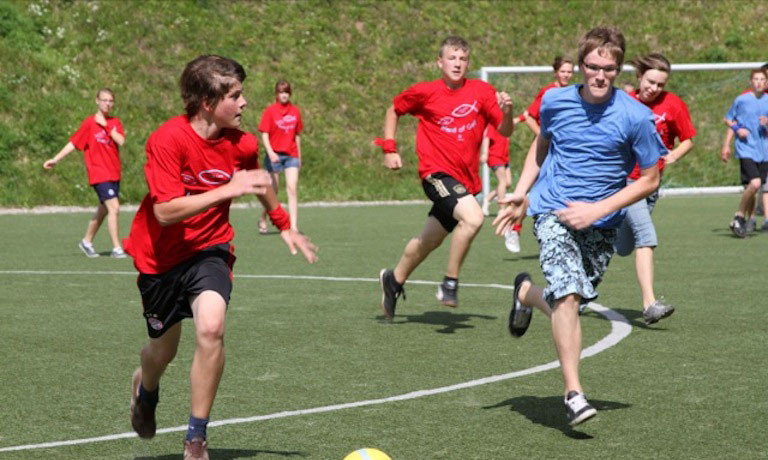Asking the Right Question
 I was recently at a conference where I got to chatting with one of our TeachBeyond missionaries—R—who related a conversation about faith matters she’d just had with several of the grade 12 students at her school. The students would bring up an issue, and R would ask them a question about it. This happened again and again, and by the end of the discussion, the students felt an urgent need to share their faith with some of their non-believing friends. Here’s what really struck me about this conversation: R didn’t offer a whole lot of instruction to the students. The bulk of her interactions was simply asking intentional questions that got the students thinking about the issues in a deeper and more directed way.
I was recently at a conference where I got to chatting with one of our TeachBeyond missionaries—R—who related a conversation about faith matters she’d just had with several of the grade 12 students at her school. The students would bring up an issue, and R would ask them a question about it. This happened again and again, and by the end of the discussion, the students felt an urgent need to share their faith with some of their non-believing friends. Here’s what really struck me about this conversation: R didn’t offer a whole lot of instruction to the students. The bulk of her interactions was simply asking intentional questions that got the students thinking about the issues in a deeper and more directed way.
As teachers, we often find ourselves feeling pressured to convey a lot of information to our students in a short amount of time. We have curriculum goals to meet, unit plans to finish, high-stakes tests to prepare students for. We want our students to learn, but we often succumb to the temptation to just tell the students what they need to know. This is, after all, the most efficient way to convey information. But we should ask ourselves: How often does this type of instruction cause our students to act directly and out of urgency–as R’s students did following their conversation?
Getting students to think deeply and directly about our subject matter should be one of the goals of our teaching. One very effective way to do this is through the art of asking questions. Not every question, however, is created equal. A team of Harvard researchers spent time looking at teacher questioning in the classroom to better understand what types of questions lead to deeper student engagement.[1] They identified five major categories of questions:
- Review Questions: asking student to recall previous knowledge and procedures (i.e., Who can tell me how nouns can function in a sentence?)
- Procedural Questions: directing classroom activity and behavior through questions (i.e., Do you have your notebooks ready?)
- Generative Questions: using questions to spark inquiry (i.e., What factors or circumstances might allow for the rise of populist leaders whose views many might find extreme?)
- Constructive Questions: asking questions that help advance student understanding (i.e., How does that connect to what we talked about yesterday? What difference does it make in how we understand this principle?)
- Facilitative Questions: helping students to elaborate on, deepen, or explain their thinking (i.e., What makes you say that?)
Unfortunately, the same study also uncovered the fact that most teachers relied primarily on the first two categories: questions that manage student behavior and rely on student recall. These types of questions do little, if anything to deepen student engagement with the material.
If we want questions to help our students think for themselves and begin to actively engage with the  material they are learning, we need to be intentional about asking more constructive, facilitative, and even generative questions. This is not something that comes naturally to many of us, so it can be very helpful to think through several of these questions prior to stepping into the classroom. Facilitative questions are the easiest to prepare in advance: what makes you say that? Can you tell me more? What do you mean by…? However, it is possible to prepare generative and constructive questions in advance as well:
material they are learning, we need to be intentional about asking more constructive, facilitative, and even generative questions. This is not something that comes naturally to many of us, so it can be very helpful to think through several of these questions prior to stepping into the classroom. Facilitative questions are the easiest to prepare in advance: what makes you say that? Can you tell me more? What do you mean by…? However, it is possible to prepare generative and constructive questions in advance as well:
- What are the big ideas that you want your students to explore as they encounter this content (generative)?
- What connections do you want them to be making (constructive)?
- What previous knowledge do they have that will help them make sense of the new material—or how will the new material change their understanding of previous knowledge (constructive)?
When we come to our lessons prepared with questions designed to encourage our students to think, we are much more likely to step off the stage and allow our students to take responsibility for their own learning. Our preparation allows us to take advantage of the opportunities that arise when students begin to think on their own. And often, we end up learning from our students in these situations as well. It’s a win/win situation!
Becky Hunsberger, M.Ed.
Coordinator of Teacher Education Services
TeachBeyond Global
[1] Ritchart, Ron. Creating Cultures of Thinking: The 8 Forces We Must Master to Truly
Transform Our Schools. San Francisco, CA: Josey-Bass, 2015. pg. 221-222.




 One of the simplest—and most effective—ways to do this is to make it a practice to include wait time after asking a question. Wait time refers to the 5-6 seconds post question where you allow your students to think about their responses. But while simple, providing wait time is not always easy. These five seconds can seem like an eternity, especially when you are confronted by that student in the second row—you know the one, the student who is frantically waving his arm in the air and practically jumping out of his seat because he wants to share his answer. It can be hard to let the students sit in silence, especially when hands start to shoot up. It takes discipline on the part of the teacher to make this practice a consistent classroom routine. It can even, at times, feel like a waste of valuable instructional time.
One of the simplest—and most effective—ways to do this is to make it a practice to include wait time after asking a question. Wait time refers to the 5-6 seconds post question where you allow your students to think about their responses. But while simple, providing wait time is not always easy. These five seconds can seem like an eternity, especially when you are confronted by that student in the second row—you know the one, the student who is frantically waving his arm in the air and practically jumping out of his seat because he wants to share his answer. It can be hard to let the students sit in silence, especially when hands start to shoot up. It takes discipline on the part of the teacher to make this practice a consistent classroom routine. It can even, at times, feel like a waste of valuable instructional time.


